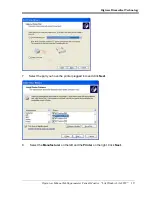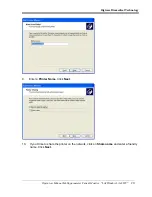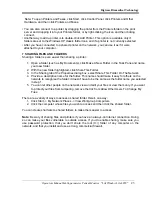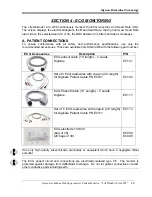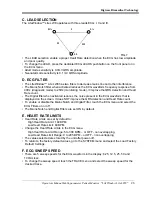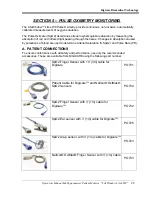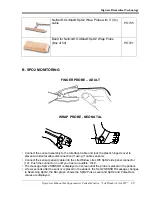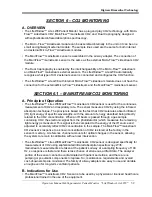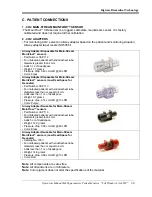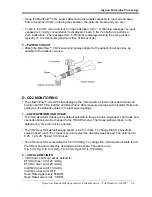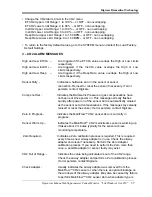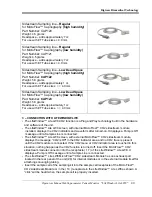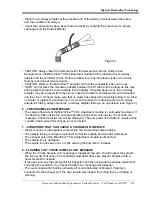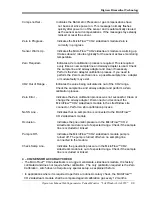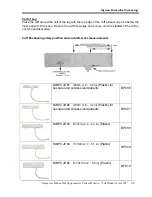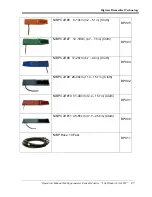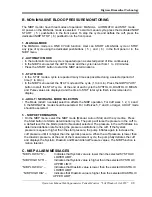
Digicare Biomedical Technology
Operators Manual Multi-parameter Patient Monitor " LifeWindow Lite LW8 "
33
• The use of the MainFlow™ mainstream CO2 Sensor is contraindicated in patients where the
physician or licensed health care professional deems it invalidated by the nature of the
patient, procedure or equipment.
WARNINGS
• Explosion Hazard: DO NOT use in the presence of flammable anesthetics. Use of the MainFlow™
mainstream CO2 Sensor in such environment may present an explosion hazard.
• Electrical Shock Hazard: Always disconnect the MainFlow™ CO2 Sensor before cleaning. Do NOT
use if it appears to have been damaged. Refer servicing to qualified service personnel.
• Follow precautions for electrostatic discharge (ESD) and electromagnetic interference (EMI) to and from
other equipment.
• Failure of Operation: If the MainFlow™ mainstream CO2 Sensor fails to respond as described in this
user guide; DO NOT use it until approved for use by qualified personnel.
• DO NOT position the sensor cables or tubing in any manner that may cause entanglement or
strangulation. Support the mainstream CO2 airway adapter to prevent stress on the ET tube.
• Reuse, disassembly, cleaning, disinfecting or sterilizing the single patient use CO2 airway adapters may
compromise functionality and system performance leading to a user or patient hazard. Performance is
not guaranteed if an item labeled as single patient use is reused.
• Inspect the CO2 airway adapters for damage prior to use. DO NOT use the CO2 airway adapters if they
appear to be damaged or broken.
• Replace the CO2 airway adapters if excessive secretions are observed.
• If the CO2 waveform (Capnogram) appears abnormal, inspect the CO2 airway adapters and replace if
needed.
• Monitor the CO2 waveform (Capnogram) for elevated baseline. Elevated baseline can be caused by
sensor or patient problems.
• Periodically check the MainFlow™ CO2 sensor and tubing for excessive moisture or secretion buildup.
• While using the MainFlow™ CO2 sensor, a system leak, such as that caused by an uncuffed
Endotracheal tube or a damaged MainFlow™ CO2 sensor may significantly effect flow-related readings.
These include flow, volume, pressure and other respiratory parameters.
• Do not operate the MainFlow™ CO2 Sensor when it is wet or has exterior condensation.
CAUTIONS
•
Electrical Shock Hazard
; the MainFlow™ CO2 Sensor is not user serviceable.
• Follow precautions for electrostatic discharge (ESD) and electromagnetic interference (EMI) to and from
other equipment.
• Use only Digicare Biomedical Technology approved accessories.
• DO NOT use the MainFlow™ CO2 sensor if it is wet or has exterior condensation.
• DO NOT use the MainFlow™ CO2 sensor if it appears to have been damaged. Refer servicing
Digicare.
• DO NOT use the MainFlow™ CO2 sensor if it fails to operate properly.
• DO NOT sterilize or immerse the MainFlow™ CO2 sensor in liquids.
• DO NOT clean the MainFlow™ CO2 sensor except as directed in this guide.
• Avoid possible damage to the MainFlow™ CO2 sensor by following the cleaning and disinfection
instructions in this guide.
• Do not apply excessive tension to the MainFlow™ CO2 sensor cable.
• Do not apply excessive tension to any sensor cable or pneumatic tubing.
• Excessive moisture in the MainFlow™ CO2 sensor may affect the accuracy of the flow measurement.
• To avoid the affects of excessive moisture in the measurement circuit, insert the MainFlow™ CO2
sensor in the ventilator circuit with the tubes upright.
• It is recommended that the MainFlow™ CO2 sensor be removed from the circuit whenever an
aerosolized medication is delivered. This is due to the increased viscosity of the medications which may
contaminate the sensor windows, causing the sensor to fail prematurely.
• Do not store the MainFlow™ CO2 sensor at temperatures less than -40º F (-40º C) or greater than 158º
F (70º C).
• Do not operate the MainFlow™ CO2 sensor at temperatures less than 32º F (0º C) or greater than 113º
F (45º C).
Содержание LifeWindow Lite LW8
Страница 1: ......

